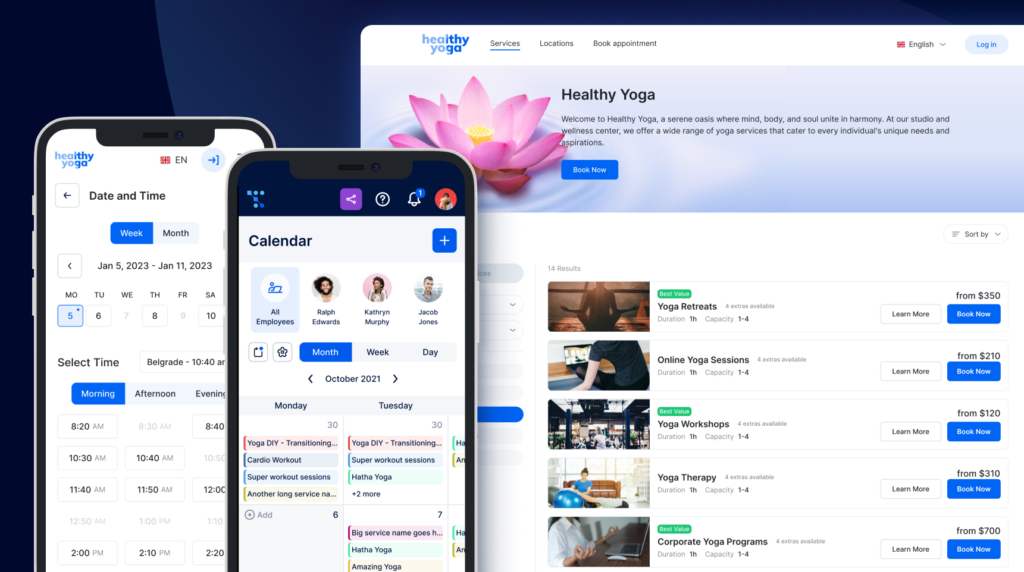Ever had those customers in your service business who are a bit more tricky to handle? Among the nice ones, there are a few who can be a puzzle to deal with. But don't worry! We're here to learn how to deal with difficult clients with ease and even use these situations to make our business better.
In a service business, we meet all kinds of customers. Some are easy-going, and some need a bit more attention. Dealing with the demanding ones might seem hard, but it's actually a chance for us to make things better.
By understanding and dealing well with these situations, we can make our service better and our business more successful.
So, let's explore some simple strategies (real-life examples included!) to handle these tricky moments and deal with difficult clients hassle-free.
How to Spot Difficult Clients?
Spotting tricky clients is a bit like noticing clues or signs in a story. Sometimes, these clients might seem okay at first, but over time, certain things start to show. They might have a habit of changing their plans often, making it tough to keep things consistent. For instance, they might book appointments and then want to change them a lot, which can lead to difficulties in organizing your schedule. Or they might bring up issues frequently, even for small things, showing that they might not be easily satisfied.
It's like seeing a puzzle come together - these clients might act in ways that disrupt the usual flow of things. They might argue a bit more or request changes that are different from what was agreed upon. These signs can help us see who might need a bit more attention or patience.
It's not about labeling clients but about understanding their needs and learning how to deal with difficult clients without disrupting our business. By noticing these patterns early on, we can prepare ourselves to handle their needs better, making their experience smoother while keeping our service running well.
How to Deal With Difficult Clients: 11 Effective Strategies
- Set Clear Expectations
- Let Your Client Vent & Listen
- Stay Calm No Matter What
- Choose Your Words Carefully
- Take a Walk in Your Client's Shoes
- Pinpoint the Problem
- Offer a Solution
- Be Quick to Reply
- Learn to Say No
- Know When to Let Go
- Learn from Your Mistakes
1. Set clear expectations
Imagine setting up road signs before a trip to show the way clearly. That's what setting expectations is like - it's about making things clear right from the start. When you explain what your service offers and what rules you follow, it helps everyone understand how things work. And mutual understanding is the key when learning how to deal with difficult clients.
Example: Let's say you're running a fitness center using booking software like Trafft for booking workouts. Beyond just saying how the booking system works, it's important to share specific details. Tell clients about the time each session lasts or if there are any rules or equipment necessary for certain exercises. This way, they know exactly what to expect before they book a workout. It's like giving them a map so they know where they're going before they start.
Including these details in the booking process helps reinforce these expectations. It's like putting up signs on the road to make sure everyone knows the way.
When everyone knows what's what right from the beginning, it makes things easier and avoids confusion later on. This way, clients feel more comfortable and confident about the services they're getting.
2. Let your client vent & listen

Image by rawpixel.com on Freepik
Ever had someone upset and wanting to talk about it? When having to deal with difficult clients, it's good to let them share what's bothering them without stopping them.
Listening carefully is like taking notes in class - it helps you remember important stuff. When a client has a problem, paying attention and writing down what they're saying shows that you care about fixing things.
Example: Imagine you run a hair salon. A client arrives upset, mentioning they booked a specific hairstyling service but didn't get the exact style they wanted. They explain their disappointment and frustration over the miscommunication.
In this scenario, it's crucial to let the client express their feelings without interruption. Listen attentively to understand their desired hairstyle and the discrepancies in communication. While they share their concerns, take notes and jot down details like the style they expected, any specific preferences discussed, and what was actually done.
Paraphrase their concerns back to them to ensure you've captured their grievances accurately. Reassure them that you're noting down the information to address the issue promptly. This demonstrates your commitment to resolving their dissatisfaction and ensuring that their preferences are understood for future appointments.
3. Stay calm no matter what
Dealing with difficult clients can be like navigating rough waters. But keeping calm is like having a sturdy boat - it helps you sail through smoothly. So, instead of getting worked up, take a moment, breathe, and approach the situation calmly. A composed attitude is like a magic wand; it can turn a tough situation into a chance for a better outcome.
Example: Picture you're managing a transportation service, and a client becomes upset due to a delay in their scheduled pick-up. They're visibly frustrated and express their annoyance, demanding immediate action.
Start by letting them know you understand their inconvenience and frustration and assure them that their concerns are being taken seriously. Apologize for the delay and promise them you'll handle the situation as quickly as possible.
By staying calm and offering quick, effective solutions, you're not just handling the immediate problem but also reinforcing trust in your service. This composed approach turns a difficult moment into an opportunity to showcase exceptional customer service and maintain a positive client relationship.
4. Choose your words carefully
When comes to learning how to deal with difficult clients properly, think of your words like tools in a toolbox - they're super important. When talking with clients, the way you say things can make a big difference. Good communication is like building a bridge; it helps connect and understand each other better.
Imagine you're talking to a friend who's upset about something. You'd choose your words carefully to show that you understand and want to help, right? That's exactly how it works with clients too. When they're not happy about something, it's important to respond in a way that shows you care and want to fix things.
Use positive language, express understanding, and respond with kindness and a willingness to solve the issue. Instead of brushing off their concerns, or, even worse, being openly rude, it's better to listen and say you understand why they feel that way. Then, offer solutions to make things better. This shows them that you're serious about making them happy and that their feelings matter.
5. Take a walk in your client's shoes
Ever thought about seeing things from someone else's point of view? That's what understanding your client's perspective is like - it's about seeing the world through their eyes. When you try to understand why they want something, it's like figuring out the reasons behind their actions.
Think about when a friend cancels plans often. Instead of getting upset, you might ask why they're doing it. It's the same with clients. If they do something a lot, like changing appointment times, there's usually a reason. Understanding this reason helps find the best way to help them.
Example: If a client keeps rescheduling their appointments because of a busy work schedule, it might mean they need more flexibility. With Trafft, you can offer them a myriad of booking options to choose from, which shows them that you get their situation and want to help. Customize the booking process, offer greater flexibility, and allow easy rescheduling with Trafft - you'll quickly turn those difficult clients into satisfied ones.
When you understand where clients are coming from, it's easier to find solutions that match what they need. It's like being a problem-solver, making things better for them based on what they go through.
Smoother Operations, Happier Clients: Experience Seamless Booking With Trafft
Seamless booking isn't just a convenience; it's a powerful tool for handling difficult clients.
Imagine a scenario where every aspect of the booking process flows effortlessly, from scheduling appointments to managing reservations. This smooth and hassle-free system becomes your greatest ally when faced with difficult clients.
By offering a booking experience that's intuitive, efficient, and error-free, you're addressing potential issues even before they arise.
Seamless booking helps avoid misunderstandings, scheduling conflicts, and client dissatisfaction. It's the cornerstone of a client-centric approach, ensuring a positive experience that leaves little room for complications or discontent.
Why Trafft booking software is your best choice:
- Efficiency at its Core: Trafft is more than just a booking system; it's your efficiency booster. Say goodbye to double bookings, confusion, and scheduling nightmares. It's designed to streamline your booking processes effortlessly.
- Seamless Client Experience: Clients love simplicity. With Trafft, they can book your services hassle-free, anytime, anywhere. From appointments to reservations, it's all about making their journey smooth and enjoyable.
- Customizable and Flexible: Your business is unique, and Trafft understands that. Customize it to match your brand, services, and booking rules. It's your platform, tailored to fit your specific needs.
- Empowerment through Automation: Leave the repetitive tasks to Trafft. Automated confirmations, reminders, and updates keep you and your clients in the loop without you lifting a finger.
- Comprehensive Solutions: Whether you're a salon, a fitness studio, or any service-based business, Trafft's got your back. It's a versatile solution for various industries, adaptable to your requirements.
- Analytics for Growth: Data-driven decisions pave the way for growth. Trafft offers insightful analytics to help you understand booking trends, client behaviors, and areas for improvement.
- Reliability and Support: Count on Trafft as your dependable partner. With robust support and regular updates, you're always equipped with the latest features and assistance.
Ready to transform your booking experience with Trafft?
6. Pinpoint the problem
Imagine a puzzle where the real problem might be hidden underneath. That's how it is sometimes with issues - what seems like the problem might not be the real one. So, it's important to dig a little deeper and find out what's really going on if you really want to learn how to deal with difficult customers effectively.
Example: Imagine you run a bakery, and a regular customer says they're not happy with the cakes they order. You might think the cake is the problem, but it's not always that simple. Maybe the real issue is something else, like the flavor or the size they wanted.
By finding the real problem, you’re fixing what really matters to the customer. This way, you also increase the Customer Satisfaction Index which measures how satisfied your clients are. It's like being a detective, solving the mystery to make sure they're happy with their cake.
7. Offer a solution
Once you know what's wrong, the next step is to come up with a plan to fix it. This shows that you're serious about making things right.
For instance, let's say there are issues with scheduling appointments that keep causing trouble. To solve this, you can suggest a personalized schedule. This way, you can work around the client's busy times while making sure it doesn't affect your other appointments much. It's like creating a plan that fits both your needs and theirs.
You can talk to the client about different times or maybe different services that could suit them more. This shows that you're willing to adapt to their needs and find a solution that works for everyone.
8. Be quick to reply
When a problem arises, knowing how to deal with difficult clients as fast as possible is crucial, as time is of the essence if you don't want things to escalate.
Example: Imagine you run a small online store selling handmade jewelry. One of your customers sends a message saying they received the wrong necklace in their order. They're upset and want it sorted out fast.
If someone complains about getting the wrong necklace, saying sorry right away is important. Explain that you're fixing the mistake immediately. Using tools to quickly update them, like sending a message through email or your website, helps them know you're on it. Offering solutions, like sending the right necklace ASAP or giving a refund, shows that you're serious about making things right.
By replying fast, you're showing that you care about their problem and are ready to fix it quickly.
9. Learn to say no
Learning how to deal with difficult clients means learning when (and how) to say no. Sometimes, it's important to say no, even if it's tough. Saying no is like setting boundaries to make sure things stay fair and balanced.
For instance, if a client keeps asking for things that your service doesn't cover, it's okay to say no. By explaining politely and offering alternatives within your services you're showing that you care about helping them, but you also have limits.
It's important to explain why you can't fulfill their request. This way, they understand it's not about refusing to help but about what's possible within your service. By doing this, you're also setting the right expectations for future interactions. It's like drawing a line to make sure everyone knows what's possible and what's not.
10. Know when to let go
Sometimes, despite our best efforts, there might be situations where continuing the relationship with a challenging client becomes too overwhelming or isn't beneficial for either party. It's a bit like when a road leads to a dead-end - it might be time to part ways on good terms. When considering this, it's essential to approach it thoughtfully and respectfully.
Start by evaluating the situation. If the relationship consistently causes stress, misunderstandings, or impacts the business negatively, it might be time for a change. Before taking any steps, reflect on why the relationship is challenging and whether there have been sincere efforts to improve it.
When starting this conversation, do it with respect and professionalism. Express your gratitude for their business and the opportunity to work together. Explain the reasons for the decision tactfully and diplomatically, focusing on how it aligns with the best interests of both parties. For example, mention the need for different approaches or specialized services that might not align with your current offerings.
Offer suggestions or alternatives if possible. Perhaps refer them to another service provider that might cater to their specific needs better. This gesture shows that you genuinely care about their satisfaction, even if it means they'll be working with someone else.
Lastly, ensure a smooth transition. Wrap up any ongoing commitments or obligations amicably. Remember, it's about parting ways professionally and preserving a positive image of your business, even in the face of a challenging situation.
11. Learn from your mistakes
When things don't go as planned, writing it down helps to understand what went wrong. This way, you can learn how to deal with difficult clients from your own experience, which will help you make things better in the future.
For example, let's say a scheduling conflict took place and caused some trouble both for you and your client. Take a moment to look at what happened, why it happened, and how it affected things. Was it a misunderstanding or a technical glitch? Understanding these factors is like solving a puzzle to figure out where things went off track.
Once you know what caused the problem, it's time to fix it. Use the information from these instances to make changes. Maybe it's about improving how bookings are handled or giving staff extra training. By making these adjustments, you're showing that you're using what you've learned to make things work better in the future.
Learning from mistakes is like growing from them; it's about becoming better by understanding what went wrong.
So, How to Deal with Difficult Clients Like a Pro?
Knowing how to deal with difficult clients in a service business can be like walking through a maze - it's not easy, but it's a chance to make things better. There are ways to turn tough situations into something positive!
First off, setting clear expectations is like drawing a map; it helps everyone know where they're going. When things get tough, staying calm is super important.
Understanding where clients are coming from helps you find better ways to help them out. And offering a solution as quickly as possible is likely to turn upset clients into satisfied ones.
By doing these things, you're turning difficult moments into chances to make your business even better. It's like turning a rough path into a smoother one, making clients happier and your business stronger!
FAQ on Dealing With Difficult Clients
1. How do you handle a difficult and unprofessional client?
Handling an unprofessional client involves maintaining professionalism from your end. Stay calm, listen attentively, and respond politely. Set clear boundaries for acceptable behavior and communicate these firmly but respectfully. If the situation escalates, consider redirecting them to a superior or suggesting a different service provider.
2. What are the 6 main types of difficult customers?
- The aggressive customer
- The indecisive customer
- The chronic complainer
- The know-it-all customer
- The unreasonable customer
- The silent or withdrawn customer
3. What not to do with a difficult client?
Avoid responding defensively or escalating confrontations. Refrain from taking their behavior personally, arguing, or using unprofessional language. Don't ignore their concerns or neglect to set boundaries; instead, focus on solutions and maintain a professional tone.
4. When should you let go of a difficult client?
Consider parting ways if the client consistently breaches terms of service, displays disrespectful behavior, or causes severe disruptions to your business. Evaluate if the relationship aligns with your values and if attempts to resolve issues have been unsuccessful despite your best efforts.
5. What is the strategy for dealing with an aggressive client?
Dealing with an aggressive client involves staying composed and acknowledging their feelings without engaging in conflict. Listen actively, show empathy, and diffuse tension by staying calm. Redirect the conversation to finding solutions and offer alternatives to address their concerns, always prioritizing safety for all involved parties.







